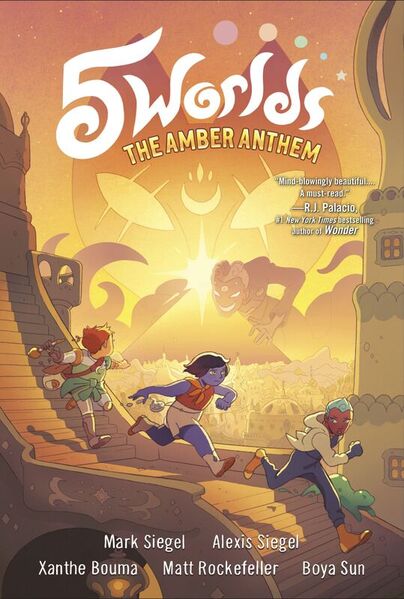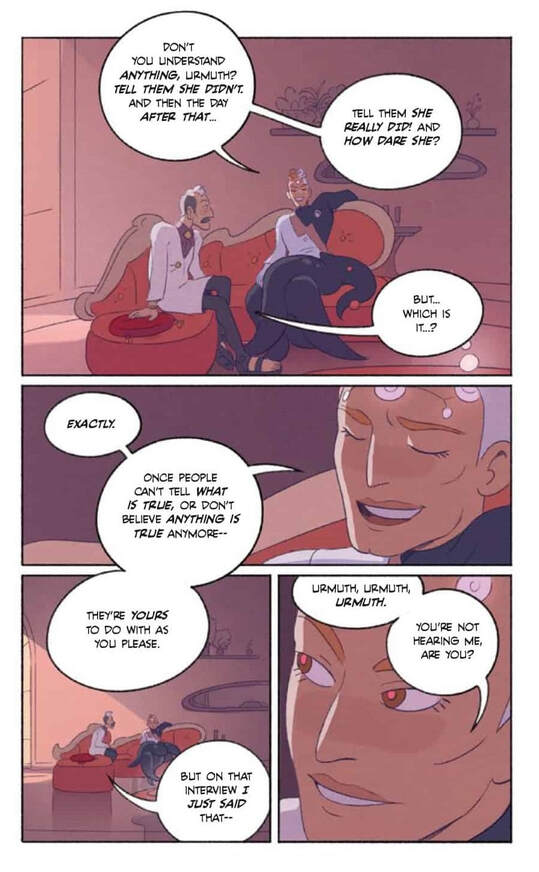|
Almost American Girl. By Robin Ha. Balzer + Bray / HarperAlley. Paperback: ISBN 978-0062685094, US$12.99. Also in hardcover, Kindle, comiXology, and Nook. 240 pages. Robin Ha’s Almost American Girl, a Korean American memoir of emigration and acculturation, evokes hard truths and traumatic memories through a mostly gentle, almost decorous style. The style belies Ha’s toughness. A complex story of cultural displacement and loss, but then again gradual near-assimilation—or, better, ongoing negotiation of identity—Almost American Girl boasts a delicate watercolor aesthetic and, by contrast, stilted digital lettering. The style is sometimes straitened or stiff, yet tender and personal; the balance suggests both tentativeness and poise. I confess, I didn’t warm to it easily—but Ha’s story has stayed with me, provocatively. Young Robin, raised in Seoul, suddenly finds herself uprooted and forced to adapt to life in the US. Her mother, a single parent, makes that choice, indeed all the choices, for them. Ha’s complex relationship to her mother—who at first, it seems, did not want this book to get made—accounts for Almost American Girl’s pointed, unsentimental, and clear-eyed qualities. The book relives Ha’s memories of anger toward her mother, which could not have been easy to set down on the page, but also portrays her mom as a self-driven woman determined to break out of a South Korean society premised on gender conformity and suffocating moralism. Gradually, Robin develops empathy for her mother’s struggles, even as she learns to be critical of stereotypic gendering in her own life—and it is her (re)discovery of comics as an artistic outlet, a move encouraged by her mom, that enables Robin to stake out these positions. So, to say that Ha’s treatment of her mother is necessarily double-edged would be an understatement. The negotiations behind the book’s making must have been complicated. Just so, the finished book is hard and sort of unfinished. Much of it replays old hurts with fresh anger. In the home stretch, though, Ha fast-forwards into life changes that bring a warmer, more resolved ending; the book seems to leapfrog to its finish. This shift perhaps comes a bit too fast, reflecting, I suppose, the YA genre’s demand for at least some provisional resolution. However, to Ha’s credit, hanging questions remain. The result is clear but not pat, and emotionally rich. Almost American Girl joins other graphic memoirs of divided identity and enculturation in the US: comics about immigrants and immigrants’ children working their way into a robust but ambivalent sense of Americanness (Thi Bui, say, or Malaka Gharib). In this post-Raina moment of comics memoirs for young readers, the graphic story of renegotiated identity has become a distinct and powerful vein of storytelling. Ha adds worthily to that growing list, with work that is at once aesthetically subdued yet piercingly written. It’s very good, and I imagine it will make a big difference for many readers. PS. Dig Ha and Raina Telgemeier’s online panel from the recent Comic-Con at Home: a warm, collegial chat (with some drawing!). This has been one of my favorites of the many online “convention” events I’ve watched recently; you can tell that these authors are used to fielding questions from readers young and old. It is hard for me to imagine a Comic-Con panel like this fifteen years ago. Thank goodness the world keeps changing! Here's the video: Also, Robin Ha has a nice how-to / process video on YouTube, from this past May, courtesy of Epic Reads: see here.
0 Comments
About eight weeks ago, I announced that KinderComics would be “taking a roughly six week-long break.” Every time I say something like that, I sigh—and sigh again when, eventually, tardily, KinderComics returns. So, okay, here I go again: Scheduling pressures under COVID, the endlessness of preparation and grading in my online teaching, and a looming sense that the world is going wrong, that it could explode any day—these things have been getting in my way. I admit I often consider closing this blog and moving on. Only reading and writing pleasure draws me back. So, let me switch gears and get down to the stuff that matters: 5 Worlds: The Red Maze. By Mark Siegel, Alexis Siegel, Xanthe Bouma, Matt Rockefeller, and Boya Sun. Random House, May 2020 Paperback: ISBN 978-0593120569, $12.99. Hardcover: ISBN 978-0593120552, $20.99. 240 pages. Who is the author of Five Worlds? This sprawling adventure series is the work of what seems to be an impossibly harmonious five-person team; somehow, the results comes across as the work of a single hand. Aesthetically, the series is gorgeous, a real feat of cartooning. Structurally, it’s tricky, with a modular, five-book shape, each book color-coded and focusing on a different world and different puzzle to solve (or secret to uncover, or McGuffin to find). Politically, it’s timely, with ever more obvious allegorical broadsides against Trumpism, neoliberalism, and xenophobia; in this progressive fantasy, world-building goes hand in hand with topical commentary that feels, as I’ve said before, on the nose. Alongside its familiar genre elements—the hype invokes Star Wars and Avatar: The Last Airbender as comparisons, but Miyazaki hovers over the whole thing too—Five Worlds conjures the anxieties of our times, and scores palpable hits against “fake news,” noxious right-wing media, climate change denial, and the shamelessness of greed-as-doctrine. KinderComics readers will know that I’ve been fairly obsessed with this series, reviewing Volumes One, Two, and Three in turn, and that I found the third, 2019’s The Red Maze, the most successful thus far at balancing genre convention, fresh discovery, and political relevance. With the latest volume, The Amber Anthem, the series has reached its fourth and penultimate act, and appears to be barreling toward a big finish. It’s actually a bit of a blur. In The Amber Anthem, the McGuffin is a song—the anthem of the title—and the story’s climax depends on thousands of voices lifted in song together, in a vision of peaceful yet powerful resistance that suggests real-world analogies: the Movement for Black Lives, and the recent surge in street protests despite COVID. (The book must have been written and drawn before that surge, and before the pandemic too, but its spirit of protest makes such analogies irresistible.) Here the dominant color is yellow, and the world is Salassandra, a planet briefly glimpsed before but now the center of the action. Our heroes, Oona, An Tzu, and Jax Amboy, once again seek to relight a long-quenched “beacon” in order to save the Five Worlds from heat death and environmental collapse. The Trumpian villain, Stan Moon—a host for the dreaded force known only as The Mimic—redoubles his attacks, even as Oona, An Tzu, and Jax take turns in the spotlight. The plot, as usual, is complicated, a tangled quest. Ordinary Salassandrans alternately help and hinder that quest (many having been persuaded that our heroes’ mission means ruin for the “economy,” and so on). The climax depends upon bringing together people of “five races.” Jax, a sports star, joined by a beloved pop singer, uses his celebrity to draw those people together—a handy metaphor for the way pop culture may provide opportunities for activism and community-building when official politics becomes hopelessly corrupt. Along the way, Anthem clears up several nagging mysteries, in particular the backstory of An Tzu (whose body has been, literally, fading away, book by book). I expected as much. Each new volume of Five World has delivered some big reveal or transformation for one of the heroes; now, with An Tzu’s history disclosed, the series seems poised for its finale. There’s a sense of unraveling complications here, yet of a tense windup at the same time. I confess that the big reveals here, though some of them came out of left field, didn’t leave me gaping or even happily stunned. Instead, I found myself jogging, not for the first time, to keep up with the frantic plot. Reveries and remembrances, sorties and missions, switchbacks and betrayals: it's a lot. The climax, though, is beatific: a shining vision of pluralism and collaboration and a lyrical evocation of “many strands…interweaving.” It's a triumphant close, but a corking good cliffhanger in the bargain, introducing a new moral dilemma and setting the stage what promises to be a breathless final volume. I’m keen—Five Worlds has been an annual stop for me, and I look forward to seeing how it all plays out. Five Worlds is a marvel of coordinated effort and cohesive design; again, its author-in-five-persons communicates like a single voice. Its world-building is lovely—I would happily pore through sketchbooks showing the collaborative process behind these books. That said, I’m starting to wonder whether the series’ complex rigging, breakneck plotting, and moral certainty are robbing it of some degree of complexity (as opposed to structural complicatedness, which it has in spades). The effect of Five Worlds on me, so far, has been like that of an action movie with soul, but its compression and momentum have not allowed for the sort of complex characterization that marks, say, Jeff Smith’s Bone, whose deepest characters, Rose Ben and Thorn, are sometimes at odds and go through hard changes. Five Worlds gestures toward the hard changes, and has enough soul to tend to the hearts and minds of its heroes, but everything feels a bit rushed. Despite the loveliness of the proceedings, then, at times the generic tropes come across as just that (Stan Moon, for example, speaks fluent Villain). When stories are ruthlessly streamlined, often what we remember are the clichés. I hope not. I look forward to the last chapter, The Emerald Gate, which I hope will bring everything—world-building, political urgency, and layered characterization—into balance one last, splendid time. When I open up the fifth and final volume, I’ll be holding my breath.
|
Archives
June 2024
|







 RSS Feed
RSS Feed
